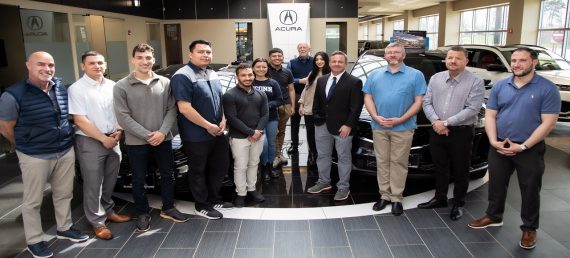Honda Engineers Create Bee Habitat on Campus
“If you had asked me two years ago if I would be a beekeeper, I would have said no way,” Chris Lang, Principal Engineer in the Drivetrain Development Division at Honda Development & Manufacturing of Americas’ (HDMA) Auto Development Center (ADC). And yet, that’s just what Lang has found himself doing—in evenings and on weekends—for the last two years.
Lang was inspired to really dig in and get involved after attending the Ohio Pollinator Symposium in 2019. “It showed me that it was so easy to make a big impact,” Lang said, who couldn’t help but then ask, “Why aren’t we involved in this?”
Lang has always had an interest in sustainability and the environment; it influenced his choice of careers and it’s long been a part of how he lives his life.
That led Lang to help establish the EARTH Business Resource Group (BRG) at ADC, in part as a way to move forward with the pollinator initiatives with Honda. The results have created an excitement that’s being felt throughout the company.
Here comes the swarm
As spring gets underway, you’ll find Lang and several other associates suited up in white bee suits on many Saturdays and weekday evenings.
They’ll be capturing swarms of bees, which involves “trying to convince swarming bees that you have a great home set up for them.”
Swarms are a result of an influx of population in the early spring—a queen and much of the population of worker bees leave the hive to look for a new home. This happens because, in early spring, the colony’s queen will lay eggs for a new queen. She then needs to leave before the new queen hatches, so, together with half the bees, they gather in a large mass, called a swarm.
The “traps” that beekeepers use are often boxes built to specific sizes, with entrances and spacing that the scout bees will see as ideal for their new colony. “We put a drop or two of lemongrass essential oil on a paper towel and put it inside a baggie. That goes in the bottom of the box.” Lang said that the fragrance helps to attract bees.
If the swarm starts to relocate to the swarm trap, the beekeeping team will come at night and move them to the bee yard, where the beehives are set up in a grouping.
“We want to make sure the bees are all ‘home’,” Lang said, which is why the swarm traps are moved to the bee yard late at night. Bees are active in the daytime—in the sun and low- or no-wind days above 50 degrees. When they’re moved at night, they can reorient the following morning. The swarm will then benefit from the care and oversight of the Honda beekeeping team.
One way the team takes care of them is helping overcome one of the hurdles facing local honeybees: varroa mites.
Honda’s super bees
Varroa mites are invasive parasites specific to honeybees that can transmit bee viruses between hives, weakening bee populations and wiping out almost all honey bee hives. In the late 1980’s commercial beekeepers and chemical companies partnered to protect the bees, using chemicals to kill the mites, but the mites became increasingly resistant.
To temporarily fill the local void in bee populations, bees are regularly imported from warmer climates. Unfortunately, they are not acclimated to Midwestern winters and are thus unable to survive long term. Replicating the more mite-resistant, Midwestern-acclimated feral bees is therefore vital. That can be done by providing hives for the feral swarms that form in the spring.
And the hives at Honda are quite buzzworthy.
A good hive typically has a varroa mite chew rate of 30 percent, but the feral bees at Honda are chewing mites at 90 to 95 percent. The chew rate refers to the bees’ behavior of chewing the legs—and sometimes the body—of the mites, thus going on the offensive toward the parasite.
Now, as the Honda bee yards expand, those bees will be growing in number and in their supported research.
Small buzz, big impact
“We want to advance this knowledge and leverage our area’s unique bee traits and landscape,” explained Mike Baumbarger, vice president of the EARTH BRG and an engineer in Materials Research. “Each hive has its own personality, but they also have their own chewing habits. That’s what some of the researchers are interested in.”
That includes Dr. Brock Harpur at Purdue University, whose thesis involves collecting, analyzing, and tabulating mite-chewing behavior. ADC engineers are supporting by sending pictures of chewed mites, using the high-powered microscopes that are in the lab. This will lead to more information about the bee genetics, which will only help the beekeeping community—and the pollination needs of the communities.
Dr. Harpur has also started a genetic tracing initiative called “16 and Bee” (think “23 and Me,” but for bees) to further understand how the chewing traits are spreading through the bee world since the discovery of the “Indiana leg chewer” bees in Indiana several years ago. The Honda bee team will be supporting Dr. Harpur with genetic testing of the Honda bees.
Dr. Reed Johnson from The Ohio State University’s Bee Lab has an interest in Honda’s bees as well. Dr. Reed’s graduate student, Harper McMinn-Sauder, is completing her thesis work by measuring hive honey production rate and comparing it to the surrounding landscape’s flora to determine the honey characteristics using pollen metabarcoding analysis.
Although other corporations have their own bee fields and hives, Honda could be “the only company known to be working with swarm trapping of feral bees and working with researchers to study the chewing behaviors and genetics,” Lang said.
Pollination destination
To support the growth of local feral bees, the EARTH team made plans to set up pollinator fields around the Auto Development Center in Raymond, Ohio. After seasonal plowing and seeding, ADC now has three pollinator fields covering nearly eight acres of land. A group of EARTH BRG members even spent a Saturday mulching a walking path around the field in the front of the Center’s main entrance.
“We also found an area along the railroad tracks between ADC and the East Liberty Plant with about two acres of naturally occurring milkweed. This can be a haven for monarch butterflies. We can save money by not mowing these areas and help the pollinators at the same time.” And that’s a sweet win.
“We had to postpone our 2020 Earth Day activities because of the COVID-19 pandemic,” Lang said, “but we were determined not to let the pollinator project get delayed.”
An important part of the pollinator project is the aforementioned “swarm trapping” of the bees that are attracted to the fields.
The goal last spring—the first spring using the swarm traps on Honda property—was to get three or four new hives from the 10 traps that EARTH members placed around ADC’s property. However – even after a late start due to COVID-19, there were eight new hives on Honda’s campus!
Honda’s large isolated and protected woods have created the perfect environment for natural selection to occur and allow the bees to prosper. There are old trees in the woods, lots of water, and no commercial bees for miles.
This year, EARTH members have set the swarm traps much earlier, in early April (which is two months sooner!). Then the two bee yards—one named for Honda and the other for Acura—will likely have to expand to allow for more hives. And because the hives expanded so well in 2020, there’s a likelihood that Honda’s bees can be sold to area beekeepers to begin quelling the importation of commercial bees.
“Our first goal is to donate feral bee swarms to 4-H and FFA kids working on pollinator projects,” Lang said. “We’ll then try to sell to amateur beekeepers and help with educating people about the importance of feral bees versus imported commercial bees.”
Even more exciting, though, is the prospect that Honda’s Marysville and East Liberty manufacturing plants (MAP and ELP) are setting up their own bee yards, trapping swarms, and beginning to take care of honeybees this spring. There are also pollinator fields being planted at HSO and PMC.
“With about 8,000 acres of Honda property here in Ohio, we could really make a difference,” Lang said.
One of the next steps is to get more associates trained in beekeeping. There’s a natural enthusiasm in the Honda community. And that’s worth its weight in honey.
Sweet as honey
“Beekeeping is just another way that we’re helping society,” Baumbarger said. As pollinators continue to decrease in number—because of parasites, pathogens, habitat loss, and pesticides—the problem is increasing in scope.
That’s why Lang is thinking big, even as he’s looking locally. “I want to collaborate with other community partners in the area,” he said. “My goal is for the whole Honda area to be a Bee Campus and then a Bee City USA.”
Last August, after the ADC beekeepers collected their first batch of honey—80 various sized jars’ worth!—they had a chance to share the honey with associates who were on-site. “Even with so many of our population working from home,” Lang said, “all our honey sold out in two-and-a-half days!” The proceeds went right back into the bees’ upkeep and outreach activities.
It’s not hard to imagine all those unused acres planted with pollinator plants and associates in bee suits, is it? After all, the classic Honda white uniforms are naturally suited to being topped with a bee veil.

